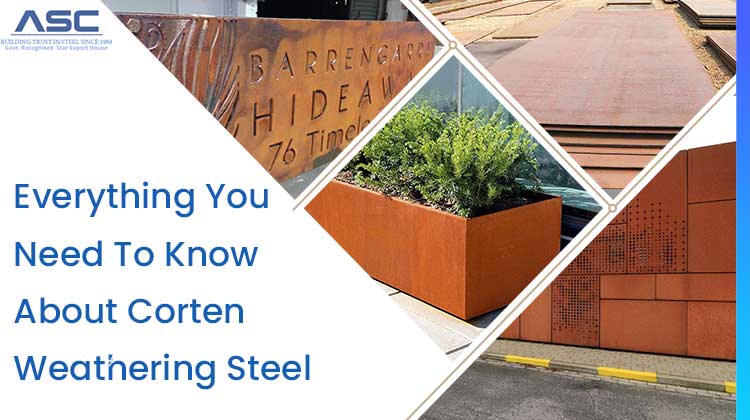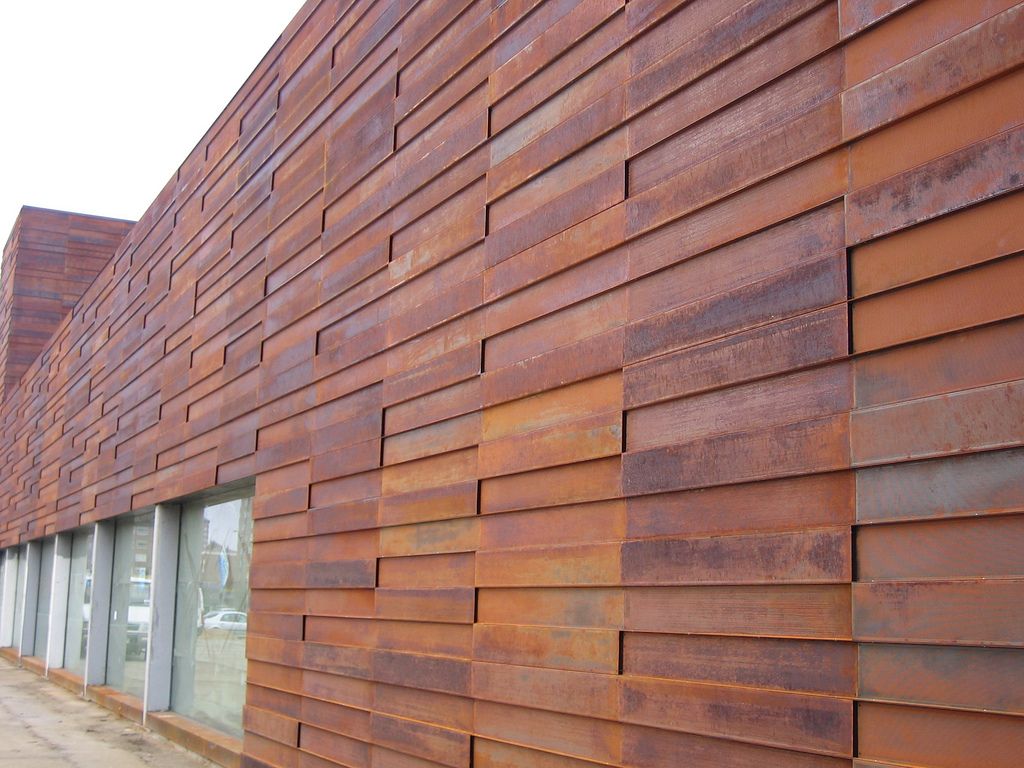Corten Steel (Weathering Steel)
by AMC
Posted on October 31, 2022 at 02:05 PM

What is Corten Steel?
Corten Steel is a group of steel alloys that are often used in outdoor buildings. It is sometimes called "weathered steel."Corten Steel was made so that it doesn't need to be painted, and if left outside in the weather, it will start to look rusted in just a few months.
How does Corten weathering Steel work?
If there is air and moisture around, most or all low alloy steels will start to rust. The rate at which this would happen would depend on how much water, oxygen, and pollution from the air it could get. As the process went on, the layer of rust would build up into a barrier that would stop the dirt, water, and oxygen from getting through. This would also help to slow down the process of rusting to some degree. After a while, this rusty layer would also come off the metal. You would be able to see that this is a cycle that would keep happening over and over.
But things would work a little differently with steel that gets better over time. Even though the rusting process would start the same way, it wouldn't go the same way from there. This is because the alloying elements in the steel would make a layer of rust that would stick to the base metal and be stable. This would then help to make a barrier that would keep moisture, oxygen, and pollutants from getting in. Because of this, the rate of corrosion would be much lower than what you'd normally find on regular structural steel.
What is Corten Steel made from?
Corten Steel is made from steel to which phosphorus, copper, chromium, and nickel-molybdenum have been added. By giving the Corten Steel a protective patina on the surface, these alloys make it more resistant to atmospheric corrosion. This patina usually takes between one and three years to form, depending on the weather and the amount of wet and dry periods that help the patina stick. Because phosphorus is present, this protective layer keeps forming on the surface and acts as a barrier against water, oxygen, and pollution.
What is Corten Steel used for?
Corten steel has been used in many different industries and projects. What are some of the most well-known projects that use Corten Steel? Here are some to give you ideas and help you understand more about this steel.
Outdoor usages
In fact, weathering steel is most often used to make sculptures for the outdoors. The Barclays Center in Brooklyn, New York, and the Humanities and Arts Complex at Leeds Metropolitan University would be two of the best examples. Also, other well-known sculptures made of Corten Steel:
Picasso sculpture in Chicago Barclays Center The Angle of North Broadcasting tower at Leeds Beckett University, and so on.
Bridges and Buildings
Aside from that, it could also be used to build bridges and other big structures. The Australian Center for Contemporary Art and the New River George Bridge are two examples.
Weathering steel has also become a popular building material for intermodal containers, marine transportation, and sheet piling that can be seen. This is something that could be seen on the recently widened M25 highway in London.
Why to Use Corten Steel?
Top 5 reasons to Use Corten Steel
- Corten weathering Steel is anti-corrosive
- Buildings made with Corten require less paint
- Corten is Useful for Heavy-Duty Structures
- Corten Weathering Steel has an attractive appearance
- Requires minimal upkeep
What is the difference between Corten Steel and Mild Steel?
Mild steel, also called plain-carbon steel, is the most common type of steel these days. Mild steel is cheaper and, once sealed, will keep its rusted look, which gives it natural character. called Penetrol. This means that the rust will keep its colour and look. Low-carbon steel has about 0.05–0.25% carbon, which makes it easy to shape and bend. Mild steel has a low tensile strength, but it is cheap and easy to shape. Carburizing can be used to make the surface harder.
It is often used when there is a need for a lot of steel, like for building structures. Mild steel has a density of about 7.85 g/cm3 (7,850 kg/m3 or 0.284 lb/in3)
Corten Steel, which is often called "Cor-Ten," is a steel that doesn't rust in the weather. A better name for it would be "Atmospheric Corrosion Resistant Steel." It is a steel alloy made of copper and chromium. This alloy is more resistant to weathering than other steels that are not alloyed. This is because the weather causes the steel to form a protective layer on its surface.
The way the alloying elements are spread out and concentrated in the protective layer is what makes it resistant to corrosion. When the weather happens, the layer that protects the surface grows and grows back over and over again. In other words, the "protective" coating is made by letting the steel rust.
How do you maintain Corten Steel?
Corten Steel products don't have rust on them when they arrive. In the pictures above, you can see how Corten Steel rusts on its own. If the item is left outside for a few weeks or months, rust will start to form on it. Depending on where it is, each product will rust in a different way.
After you get the Outdoor oven, you can use it right away. You don't have to do anything to it before using it. When adding wood to the fire or opening the door, you should always be aware of how hot it is.
Cleaning and maintenance
- To make your Outdooroven last longer, you should clean the steel at least once a year with a stiff brush.
- Take off any dirt or leaves that are on the Outdooroven because they can affect the rust layer.
- Make sure that your product is in a spot where it can dry quickly after it rains.
Corten Steel Advantages
Easy To Maintain - When using exposed weathering steel, some of the only things that would need to be done for maintenance are to check on it from time to time and clean it. In terms of regular cleaning, this would mean rinsing the rusted parts with water to get rid of any dirt or natural debris. Aside from that, dents and scratches would be helped by the oxide structure, which would heal itself over time so that it wouldn't need to be replaced.
Cost Saving - Since we're talking about long-term investments, you should think about how much money you could save. This is because there would be no reason to use Corten Steel for building projects if there was no way to save money.
Because Corten Steel is strong and lasts a long time, you would save money in the long run. This is easy to see when you look at buildings from almost fifty years ago. In fact, this is used all over the world because it lasts long and saves money in the long run. By taking advantage of this material's ability to protect and stay alive, it would also help to avoid the high costs of painting. Not only that, but whole-life costs could also be cut if maintenance like painting was done on-site. Weathering steel seems like the best choice when it would be hard or dangerous to get to furniture to fix it or when traffic needs to be interrupted as little as possible.
Environmental Benefits - At the same time that it would be important to save money, it would also be important to protect the environment. By going above and beyond LEEDS requirements and having other green features, like being made from recycled materials and being 100% recyclable, you would do a lot for the environment. If you look around a bit on the Internet, you can find a lot of different kinds of information.
Dynamic Texture and Appearance - Weathering steel that has been around for a long time will help buildings look more three-dimensional. This is because the patina could change from wet to dry and back again several times a day. This would also bring a sense of awe and depth with it. In short, this steel would turn into a lot more than you thought it would. You would be able to see the subtle look that was hiding behind the exposed surfaces, waiting to be found and experienced in a new way. As a result, there aren't many building materials that can offer this level of sophistication and complexity. With its many different colours and tones, the patina would continue to get better and blend together as it aged. As the oxide layer grew, earthier tones would come to the surface.
Minimal Cost - Raw Corten Steel is the best choice if you want to get the best results for the least amount of money and with the fewest steps. This is because it would cut down on the time it takes to get cladding materials and the money they would cost. When you first used this steel, you might have seen a flash of rust that would then settle down. But you wouldn't have to worry about that because it would run off and get on the other surfaces. If you want to deal with this, you could build a catch system or gutter into the design. This would help move loose ferrites or hide them.

Benefits And Rusting Capabilities Of Corten Steel
Corten steel commonly known as weathering steel, is highly resistant to rusting and pitting when exposed to the elements. In order to preserve itself, this steel forms an oxide coating.

